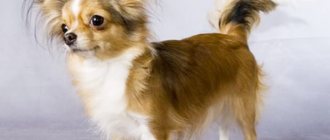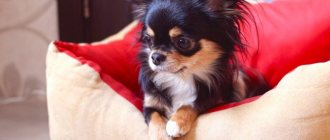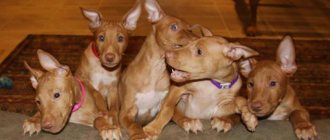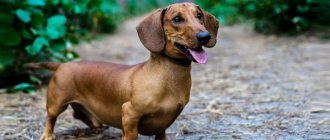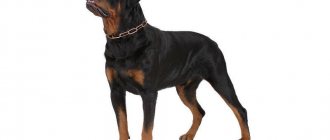Docking of Doberman dogs is the removal of ears and tails by surgical intervention. There is no consensus on this procedure: some people believe that Dobermans must have their ears and tail cropped, while others do not share this point of view, citing this as a reason for animal abuse and cruelty. This article will discuss historical aspects, the need for the procedure for Dobermans, the pros and cons, the recommended age for the operation, and its progress. The topic of where the operation is performed and its cost will also be covered with a summary.
History of tail and ear docking
This procedure was first used by Dobermans by the ancient Romans. Legionnaire dogs were among the first to be docked in order to maximally protect the Doberman from injury. This significantly increased the level of combat readiness and endurance. One of the famous Roman scientists, whose works were written about agricultural activities, said that local dog breeders firmly believed that if the caudal vertebrae were eliminated on the puppy’s 40th birthday, the tail would no longer grow, which would save the Doberman from such an insidious and a dangerous disease like rabies, which, as we know, has no cure.
A little later, other aspects appeared in favor of docking the tails and ears of Dobermans. The main goal was still considered the safety of the dog during active hostilities, hunting and possible damage from thorns and foxtail, accidental contact with which caused unpleasant discomfort in the animal.
Another reason why docking was performed was the financial interest of Doberman owners. The fact is that a dog tax was introduced in England and docking was an excellent opportunity to avoid tax liability. Using this procedure, dog breeders could show that the pet is not a hunting one. Only those individuals that had a long tail were recognized as such.
Docking a body part soon became the standard for winning at international exhibitions, and by that time safety had already lost its leading position. More than a century has passed since then, and the popularity of ear and tail docking among Dobermans is at a stable level.
Character
The Doberman has a very unique character; it is not like many other breeds. He will protect the owner at the cost of his life, but at the same time he can be sentimental, he is aggressive, always vigilant and ready for a fight at any moment, but at the same time he can selflessly fool around in the clearing with the neighbor's puppy. This is a reliable, intelligent guard and a completely devoted friend and companion to the owner.
Anyone who enters a house in the absence of the owners is considered a potential enemy. Dobermans are hot and impatient, they are always ready for a swift attack, but at the same time they are aware of their strength and have a subtle mind, they know how to analyze and differentiate situations. Dobermans feel their mood very clearly and are rarely pushy. This is a fairly temperamental breed of dog, but sudden mood swings are not typical for them.
A well-bred Doberman is not a bully, he is not timid, but he will not show aggression unnecessarily.
The Doberman is a ferocious, quarrelsome and vicious dog for an ill-wisher, but in the family it is a good-natured, sweet and affectionate creature that treats children well and kindly. Of course, provided that the dog has been familiar with children since childhood and is well socialized. Dobermans become very attached to members of their “pack”, but it is important to take into account and respect his interests.
It is worth noting that Dobermans can be very different from each other. So, one dog will be attached to a specific person, and the other dog will be oriented towards the whole family. Some Dobermans, depending on their upbringing, can be more aggressive, while others are the opposite. Much depends on the conditions in which they grew up and, of course, their upbringing.
Does a Doberman need to have his ears cropped?
As it has already turned out, a remarkable tradition has its roots in the distant past. And if at that time the opinion was unanimous, now there are both supporters and opponents of the operation for the Doberman. In general, the ancestor of this breed is Louis Doberman, which is why the dogs received their official name. His goal was to create a universal fighter with good health. Ear and tail docking has become an effective method in the prevention of rabies and ear infections.
Modern ideas have long changed; docking is no longer mandatory and is performed at the personal discretion of the Doberman owner, although if we take into account the physiological characteristics of the breed, docking is beneficial for the dog’s health. The fact is that due to the natural structure of the auricle, the Doberman is prone to otitis media. That is why the ears need to be carefully cared for and undocked pets in this case are more susceptible to this problem. An effective prevention is periodic examination of the auricle by the owner or veterinarian to diagnose inflammation.
As for the appearance of the Doberman, a dog with undocked ears looks quite cute. It is the integral view that is considered natural and correct according to all natural laws.
Features of the appearance of the breed
How is the Russian Spaniel different? How to train this breed of dog to hunt? Its representatives have proven themselves well in Russian conditions. In our country, the breed appeared at the turn of the 19th-20th centuries.
The standard for the Russian Spaniel intended for hunting was approved in 1951. Significant diversity in the breed was allowed, which led to the emergence of different regional types with differences.
The modern Russian hunting spaniel has a height at the withers of 40-45 centimeters. The dog is distinguished by a small, dry head and expressive dark eyes. The dog is distinguished by its cheerfulness and lightning-fast movements.
The coat is smooth and wavy, so the Russian Spaniel suffers less from thorns when hunting. The breed is adapted to hunting various game birds in any area of the country. During a hunt, the dog searches for game, reacts to the owner’s shot, and hands the killed bird to the hunter.
Pros and cons of cupping
Now let's look more specifically at the advantages and disadvantages of the procedure.
Pros of cupping:
- improving health, reducing the risk of ear diseases;
- imparting rigor to appearance, improving aesthetic qualities;
- full compliance with the breed standard, which is an official pass to international exhibitions;
- ears and tail often get in the way when chasing an unscrupulous person. The more protruding parts of the body, the higher the likelihood of injury.
Disadvantages of cupping:
- the procedure cannot be called painless. The Doberman experiences unbearable pain during the operation, whines pitifully and tries to escape. In other words, during surgery the dog is stressed and it can be difficult to get him out of this state;
- cupping must be done in puppyhood, when they can easily tolerate anesthesia. The postoperative period in adult dogs is much worse and can drag on for a long time;
- there is a high probability of difficult wound healing, the occurrence of postoperative scars and scars. The development of unforeseen complications during the recovery period is also not excluded;
- participation in international exhibitions is impossible;
- the difficulty of communicating with representatives of its own species, since the animal’s ears take a standing position, which for other dogs is a sign of aggression and readiness to attack at any moment.
Price
The younger the Doberman is, the cheaper docking costs. Puppies up to a month old can have drooping ears installed for 500-1000 rubles. The price of the operation for puppies up to six months is 2000-3000 rubles.
The veterinarian can come to your home with tools and medications. In this case, the cost of trimming the skin increases by 1000 rubles. The final amount is also influenced by the dosage of anesthesia, the qualifications of the doctor and the prestige of the clinic.
In our country, the Dobermann, which has an undocked tail, differs in appearance from its brothers in the brood. Why is this part of the dog’s body cut off? When an adult animal wobbles, it can injure itself on bushes, trees, or furniture. The likelihood of other dogs biting this protruding area increases. The price of such cupping is 3000-5000 rubles.
Is surgery possible at other ages?
If the best time is missed, then this is not a reason to be upset. A 3 month old Doberman puppy can have his tail docked safely. But this is an extreme period.
Going beyond the time frame is fraught with complications, which is dangerous for the health of the Doberman.
Docking a puppy older than 3 months is strongly not recommended.
When to do it?
Owners have practically no time to think, since surgery is carried out at a very early age.
Veterinarians insist that the most successful period is 3-10 days after birth. During this period, the nervous system has not yet fully formed; blood circulation in the newborn’s body occurs more slowly than usual, which means there will be fewer problems with blood loss. And the healing processes occur much faster, which also speaks in favor of an early procedure.
Often, if the puppies are too weak or do not yet have owners, the decision is delayed for several weeks. In this case, the breeder has time to think until the age of 2 months. Such adults are trimmed under anesthesia in order to reduce the level of torment of the animal.
The operation can be performed later, but the chances of placing the ears correctly are then significantly reduced. Moreover, veterinarians strongly do not recommend plastic surgery after the teeth begin to change , since at this time the entire flow of useful substances is directed towards the formation of bone tissue, which means that trimming and recovery after it will be much more difficult than it could be.
How to crop a Doberman's ears
Cupping requires prior administration of anesthesia. Used both local and general. The duration of the procedure is approximately = 30-120 minutes.
To begin, the Doberman lies sideways on the couch or operating table. Next, the dog is immobilized and muzzled. The baby's ears are straightened by applying a pattern and pushing the skin to the base. The device is left until it is given the desired shape. This is necessary to prevent the dog from bleeding.
Preparing for surgery
First of all, you should make an appointment with a veterinarian, who will issue a referral for urine and blood donation, and in some cases will require an ultrasound examination of the organs. All these measures are aimed at eliminating the body’s negative reaction to the administration of anesthesia, and the puppy itself is prepared as follows:
- carry out cleaning from worms and other parasites with special preparations no later than 14 days before the proposed operation;
- adjust the diet. The day before the procedure, the dog is not given food, but it is possible to drink water;
- the cut area is shaved;
- on the appointed day, body temperature is periodically measured, the normal value of which lies in the range of 37-39 degrees.
Stages of the procedure
Tail docking occurs by eliminating 2/3 of the tail or another length prescribed by the breed standard. There are 2 ways of circumcision:
- surgical. It is advisable to use docking in this way if the puppy is already 1 month old. The length of the tail is removed as follows: using inhalation, medications are administered internally to prevent increased salivation. Next, a tube is inserted to ventilate the air and prevent the tongue from sinking. They carry out all the technical details. A disinfecting bandage with an antibiotic is applied on top.
- conservative. This type of relief is considered a lightweight option, because it does not require the use of anesthesia or medical intervention. But the method is painful for the Doberman himself. Its essence is to tighten the tail with an elastic tourniquet, as a result of which blood circulation stops and the tail simply falls off.
Nutrition
Dobermans are quite unpretentious in their diet. If you decide to give preference to natural food, then you should not forget about meat as the main source of protein. Meat products should make up half of the entire diet, and in some cases (intense physical activity, cold season, etc.) 75% of the entire menu. It is impossible to raise a healthy and active dog on cereals alone. The diet must include vegetables, fruits, herbs, dairy products, eggs and fish. Another option would be to feed a balanced dry food. Portions must be calculated based on the weight of each individual dog.
How to position the ears
Cropped ears can be installed on a Doberman after surgery or during the recovery period. Staging is usually performed by a veterinarian. The crown is made as follows: a special prismatic metal structure is taken as the basis. It is stuffed with cotton wool and secured with a bandage to give it softness. Next, take 2 strips of plaster, 10 cm each, and glue them to the inside of the ears. The auricle is tightly attached to the crown, and the patch is fixed crosswise inside. A similar procedure is repeated with the second hole. This crown is usually worn for about 6 months and then removed.
How to care for your ears
The veterinarian writes out recommendations that must be strictly followed. Typically, the postoperative period for a puppy goes quickly and does not require much effort.
However, if the baby is too restless, then he needs pain relief.
Every day throughout the entire recovery period after cupping, the wound is treated with antiseptics. After 2 weeks, the stitches are removed, and then the ears can be installed. To speed up the healing process, it is allowed to do a manual massage in the direction from bottom to top.
Postoperative care
It is very important, because if you don’t watch your baby, the baby will scratch his healing ear, ruining its shape and causing infection in the wound. Treat the seams with tampons soaked in brilliant green or peroxide (it is best to alternate: brilliant green day, peroxide day). It is best to put a collar on the neck to prevent the puppy from scratching its ears.
Representatives of some breeds require special gluing in order for their ears to stand up nicely.
On the 2nd day after surgery, you can very carefully massage the auricle so that the skin does not “wrinkle” as the edge heals. Stitches are usually removed after 7-14 days
If something alarms you, your pet’s temperature rises, severe swelling of the shell or even pus appears, then contact our clinic immediately. Our specialists will come to your aid immediately, or you can call a veterinarian to your home.
Where is the best place to carry out the procedure?
Doberman tail and ear docking is recommended to be performed in a veterinary clinic under the guidance of an experienced doctor, since this surgical procedure must be fully supervised to avoid complications with irreversible consequences for the health of the Doberman.
Indications
The decision to dock a dog's tail is made by the owner of the animal or (in case of medical indications) by a veterinarian.
The veterinarian may decide to amputate the tail regardless of the breed of the animal. Indications for such an operation are serious injury, extensive burns, frostbite, malignant neoplasm, and other damage to the tail. Such situations are quite rare.
In the vast majority of cases, the tail is docked to meet standards. This procedure is carried out for fighting, hunting, and some decorative breeds. These include:
- alabai;
- Dobermans;
- poodles;
- Rottweilers;
- Yorkshire Terriers;
- spaniels;
- kurtshaars;
- Giant Schnauzers;
- miniature schnauzers and others.
Both supporters and opponents of docking have their own compelling arguments.
